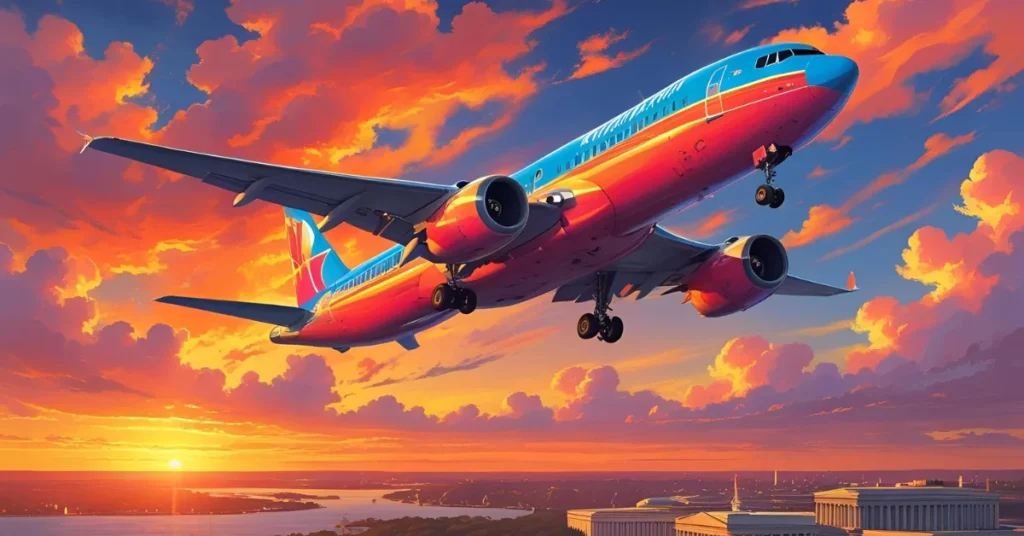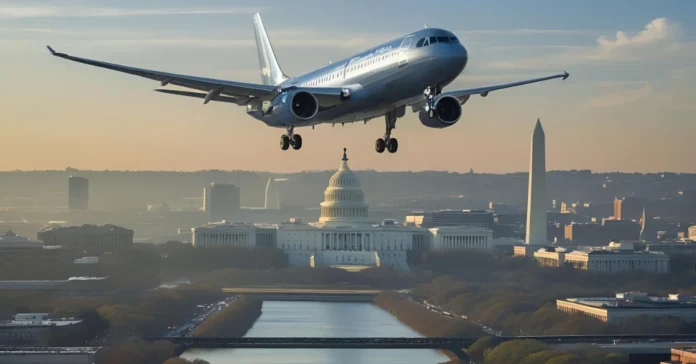Here is the latest FAA update on restricted airspace around Washington D.C., including new requirements for pilots, safety protocols, and the implementation of a visual warning system.
Overview
On April 10, 2025, the Federal Aviation Administration (FAA) issued an update about the Washington D.C. Metropolitan Area Special Flight Rules Area (DC SFRA).
This is a restricted airspace that extends about 30 nautical miles from Washington, D.C., surrounding a special zone known as the Flight-Restricted Zone (FRZ).
The Leesburg Executive Airport marks the edge of the Special Flight Rules Area (SFRA), where a specific maneuvering area is set up to help planes take off and land more easily.
To fly within the SFRA, pilots must follow strict rules. They need to get permission in advance from FAA air traffic control. Planes must also have working altitude-encoding transponders to communicate their locations. When given permission, pilots receive a special four-digit number for identification.
They must always keep in touch with air traffic control unless they are cleared to connect with local area frequencies.
The FRZ itself is more restrictive, covering 15 nautical miles around Ronald Reagan Washington National Airport. Only commercial flights are allowed in this zone.
Other general aviation aircraft can also fly in this area under specific conditions laid out by the Transportation Security Administration (TSA).
The FAA can impose temporary flight restrictions for security reasons, such as government officials’ visit, or during special events like air shows.
Pilots are reminded to check ahead for any flight restrictions and can find all necessary information through FAA channels. There is even a visual warning system that uses light signals to alert pilots who may accidentally enter restricted airspace.
It’s crucial for pilots to follow these safety guidelines to avoid serious consequences.
Key Highlights

- The DC SFRA has a 30 nautical mile radius around Washington, D.C.
- Pilots require prior FAA clearance to enter the SFRA.
- The FRZ restricts flights near Ronald Reagan Washington National Airport.
- Temporary flight restrictions can be enacted for security and safety.
- A visual warning system alerts unauthorized aircraft in restricted airspace.
Issued By:
Federal Aviation Administration (FAA)
Document Ref:
FAA Special Flight Rules Area Update, April 10, 2025
What’s New?
The FAA recently updated rules regarding the Washington D.C. airspace, specifically the Special Flight Rules Area (SFRA) and the Flight-Restricted Zone (FRZ).
The SFRA, which extends 30 nautical miles around Washington, D.C., requires pilots to secure advanced clearance before flying there. Additionally, all aircraft must be equipped with an altitude-encoding transponder and must remain in contact with air traffic control.
The FRZ, which is a more restricted area around Ronald Reagan Washington National Airport, allows only certain flights without a waiver. Pilots must follow strict guidelines when flying in or near these zones, as violations could lead to suspension of their flying privileges or even legal actions.
The FAA can impose temporary flight restrictions for security or special events, and pilots must stay informed of these changes.
A new visual warning system, utilizing red and green lights, will alert pilots who enter these airspaces without authorization. Compliance with these regulations is essential for safety and security.
Who Is Affected?
This update affects all pilots flying within the Washington D.C. area, particularly those operating near the SFRA and FRZ.
It is crucial for general aviation pilots, commercial airline operators, and those who conduct private flights in this region. Those who apply for waivers for flying within these zones must also comply with the updated regulations.
What is the background of this update?

The FAA created the Washington D.C. SFRA and FRZ in response to security concerns following the attacks on September 11, 2001.
These areas were established to protect critical government sites, including the Washington Monument, the White House, and the U.S. Capitol.
The SFRA helps manage air traffic around the busy capital area, while the FRZ prohibits most flights to ensure maximum security, only allowing scheduled commercial flights and government-authorized aircraft.
Over the years, the FAA has updated the rules and procedures to improve safety and efficiency. The need for clear communication between pilots and air traffic control is vital for navigating these restricted regions, and this update reinforces the importance of compliance due to ongoing security threats.
The FAA aims to provide a safe environment for both aviation operations and national security, making adjustments based on lessons learned from past incidents and current needs.
Editor’s Insight
The update regarding the restricted airspace around Washington D.C. is a crucial development for pilots who operate in this area.
It reflects the FAA’s commitment to ensuring airspace security while allowing for effective air traffic management. The specific rules and requirements outlined serve as a necessary reminder for all pilots to stay vigilant and compliant.
As we see heightened security measures, it is essential for pilots to stay informed about their surroundings and any temporary restrictions that may arise. The introduction of the visual warning system is an innovative way to enhance communication and awareness.
While these regulations may seem strict, they exist to protect the public and ensure safety in an area that is not only bustling with air traffic but is also home to many government officials. Keeping the lines of communication open between pilots and air traffic control is key.
As aviation continues to evolve, staying up-to-date with regulations will help foster safety and confidence in our skies.
Official Source:
For more information, visit the FAA’s official website at FAA.gov.



